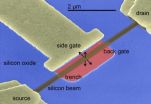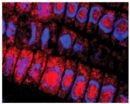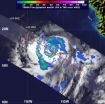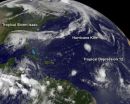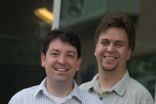(Press-News.org) KANSAS CITY, MO—The skin, the blood, and the lining of the gut—adult stem cells replenish them daily. But stem cells really show off their healing powers in planarians, humble flatworms fabled for their ability to rebuild any missing body part. Just how adult stem cells build the right tissues at the right times and places has remained largely unanswered.
Now, in a study published in an upcoming issue of Development, researchers at the Stowers Institute for Medical Research describe a novel system that allowed them to track stem cells in the flatworm Schmidtea mediterranea. The team found that the worms' stem cells, known as neoblasts, march out, multiply, and start rebuilding tissues lost to amputation.
"We were able to demonstrate that fully potent stem cells can mobilize when tissues undergo structural damage," says Howard Hughes Medical Institute and Stowers Investigator Alejandro Sánchez Alvarado, Ph.D., who led the study. "And these processes are probably happening to both you and me as we speak, but are very difficult to visualize in organisms like us."
Stem cells hold the potential to provide an unlimited source of specialized cells for regenerative therapy of a wide variety of diseases but delivering human stem cell therapies to the right location in the body remains a major challenge. The ability to follow individual neoblasts opens the door to uncovering the molecular cues that help planarian stem cells navigate to the site of injury and ultimately may allow scientists to provide therapeutic stem cells with guideposts to their correct destination.
"Human counterparts exist for most of the genes that we have found to regulate the activities of planarian stem cells," says Sánchez Alvarado. "But human beings have these confounding levels of complexity. Planarians are much simpler making them ideal model systems to study regeneration."
Scientists had first hypothesized in the late 1800s that planarian stem cells, which normally gather near the worms' midlines, can travel toward wounds. The past century produced evidence both for and against the idea. Sánchez Alvarado, armed with modern tools, decided to revisit the question.
For the new study, first author Otto C. Guedelhoefer, IV, Ph.D., a former graduate student in Sánchez Alvarado's lab, exposed S. mediterranea to radiation, which killed the worms' neoblasts while leaving other types of cells unharmed. The irradiated worms would wither and die within weeks unless Guedelhoefer transplanted some stem cells from another worm. The graft's stem cells sensed the presence of a wound—the transplant site—migrated out of the graft, reproduced and rescued their host. Unlike adult stem cells in humans and other mammals, planarian stem cells remain pluripotent in fully mature animals and remain so even as they migrate.
But when Guedelhoefer irradiated only a part of the worm's body, the surviving stem cells could not sense the injury and did not mobilize to fix the damage, which showed that the stem cells normally stay in place. Only when a fair amount of irradiated tissue died did the stem cells migrate to the injured site and start to rebuild. Next, Guedelhoefer irradiated a worm's body part and cut it with a blade. The surviving stem cells arrived at the scene within days.
To perform the experiments, Guedelhoefer adapted worm surgery and x-ray methods created sixty to ninety years ago. "Going back to the old literature was essential and saved me tons of time," says Guedelhoefer, currently a postdoctoral fellow at the University of California, Santa Barbara. He was able to reproduce and quantify results obtained in 1949 by F. Dubois, a French scientist, who first developed the techniques for partially irradiating planarians with x-rays.
But Guedelhoefer went further. He pinpointed the locations of stem cells and studied how far they dispersed using RNA whole-mount in situ hybridization (WISH), specifically adapted to planarians in Sánchez Alvarado's lab. Using WISH, he observed both original stem cells and their progeny by tagging specific pieces of mRNA . The technique allowed him to determine that pluripotent stem cells can travel and produce different types of progeny at the same time.
"In other systems, most migrating stem cell progeny are not pluripotent," says Guedelhoefer. "For the most part, blood stem cells in humans stay in the bone marrow but their progeny leave and turn into a few other cell types." But in planarians, it looks like those two things are completely separate. Stem cells can move and maintain the full potential to turn into other types of cells."
Next, Sánchez Alvarado looks forward to implementing genetic screens and transplantation experiments to disrupt or enhance the cellular behaviors the team observed, to figure out the "rules of engagement" for stem cell migration, he says.
"Why can some animals regenerate whole body parts but you and I are not good at it?" says Sánchez Alvarado. "Can we write an extra rule or erase one? Is it possible, for instance, to get rid of cancer while gaining regenerative properties? These are questions we'd love to have answers to."
INFORMATION:
The Stowers Institute for Medical Research, a National Institutes of Health Training Grant (5T32 HD0791), a National Institutes of Health Grant (GM057260), and Howard Hughes Medical Institute provided funding for this work.
About the Stowers Institute for Medical Research
The Stowers Institute for Medical Research is a non-profit, basic biomedical research organization dedicated to improving human health by studying the fundamental processes of life. Jim Stowers, founder of American Century Investments, and his wife, Virginia, opened the Institute in 2000. Since then, the Institute has spent over 900 million dollars in pursuit of its mission.
Currently, the Institute is home to nearly 550 researchers and support personnel; over 20 independent research programs; and more than a dozen technology-development and core facilities.
Moving toward regeneration
Stowers scientists show how pluripotent stem cells mobilize in wounded planarian worms, to better understand stem cell behavior in regeneration and disease
2012-08-31
ELSE PRESS RELEASES FROM THIS DATE:
Health reform: How community health centers could offer better access to subspecialty care
2012-08-31
FINDINGS:
The Affordable Care Act will fund more community health centers, making primary care more accessible to the underserved. But this may not necessarily lead to better access to subspecialty care.
In a new study, researchers from the David Geffen School of Medicine and Robert Wood Johnson Foundation Clinical Scholars program at UCLA and colleagues investigated the ways in which community health centers access subspecialty care. They identified six major models and determined which of those six offered the best access:
Tin cup ...
Researchers measure photonic interactions at the atomic level
2012-08-31
DURHAM, N.C. -- By measuring the unique properties of light on the scale of a single atom, researchers from Duke University and Imperial College, London, believe that they have characterized the limits of metal's ability in devices that enhance light.
This field is known as plasmonics because scientists are trying to take advantage of plasmons, electrons that have been "excited" by light in a phenomenon that produces electromagnetic field enhancement. The enhancement achieved by metals at the nanoscale is significantly higher than that achievable with any other material.
Until ...
'Nanoresonators' might improve cell phone performance
2012-08-31
"There is not enough radio spectrum to account for everybody's handheld portable device," said Jeffrey Rhoads, an associate professor of mechanical engineering at Purdue University.
The overcrowding results in dropped calls, busy signals, degraded call quality and slower downloads. To counter the problem, industry is trying to build systems that operate with more sharply defined channels so that more of them can fit within the available bandwidth.
"To do that you need more precise filters for cell phones and other radio devices, systems that reject noise and allow signals ...
Discovery may help protect crops from stressors
2012-08-31
VIDEO:
Scientists at the Salk Institute for Biological Studies have discovered a key genetic switch by which plants control their response to ethylene gas, a natural plant hormone best known for...
Click here for more information.
LA JOLLA, CA----Scientists at the Salk Institute for Biological Studies have discovered a key genetic switch by which plants control their response to ethylene gas, a natural plant hormone best known for its ability to ripen fruit, but which, under ...
Biophysicists unravel secrets of genetic switch
2012-08-31
When an invading bacterium or virus starts rummaging through the contents of a cell nucleus, using proteins like tiny hands to rearrange the host's DNA strands, it can alter the host's biological course. The invading proteins use specific binding, firmly grabbing onto particular sequences of DNA, to bend, kink and twist the DNA strands. The invaders also use non-specific binding to grasp any part of a DNA strand, but these seemingly random bonds are weak.
Emory University biophysicists have experimentally demonstrated, for the fist time, how the nonspecific binding of ...
NASA spotted hot towers in Ileana that indicated its increase to hurricane status
2012-08-31
Hot Towers are towering clouds that emit a tremendous amount of latent heat (thus, called "hot"). NASA research indicates that whenever a hot tower is spotted, a tropical cyclone will likely intensify. Less than 14 hours after the TRMM satellite captured an image of Ileana's rainfall and cloud heights, Ileana strengthened into a hurricane on Aug. 29.
NASA's Tropical Rainfall Measuring Mission (TRMM) satellite captured a view of Ileana's rainfall rates on Aug. 29 at 2:17 a.m. EDT and saw the heaviest rainfall rates, near 50 mm (2.0 inches) per hour in a band of thunderstorms ...
NASA sees Tropical Storm Tembin make landfall in South Korea
2012-08-31
Tropical Storm Tembin made landfall in the in southwestern South Korea and NASA's Aqua satellite captured the extent of the storm's elongated cloud cover, revealing the effect of wind shear on the storm.
Tembin moved through the Myeongnyang Strait and made landfall on Aug. 30, 2012 at 0000 UTC (Aug. 29 at 8 p.m. EDT) in the southwestern tip of South Korea.
NASA's Aqua satellite's Moderate Resolution Imaging Spectroradiometer (MODIS) instrument captured a visible, true-color image of Tropical Storm Tembin around the time of landfall in southwestern South Korea. The image ...
NASA spies fifth Atlantic hurricane and twelfth tropical depression
2012-08-31
Tropical Storm Kirk intensified into a hurricane today, Aug. 30, while another tropical depression was born. Satellite imagery revealed Hurricane Kirk and newborn Tropical Depression 12 romping through the central Atlantic Ocean today, while Tropical Storm Isaac continues to drench the U.S. Gulf coast and Mississippi Valley. Kirk became the Atlantic Ocean season's fifth hurricane today, Aug. 30.
On Aug. 30 at 7:45 a.m. EDT, a visible image from NOAA's GOES-13 satellite captured all three tropical cyclones in a panoramic shot of the Atlantic Ocean basin. The visible image ...
Rice, MD Anderson scientists probe mystery of operon evolution
2012-08-31
HOUSTON -- (Aug. 30, 2012) -- The threads of an evolutionary mystery that dates to the birth of molecular biology are beginning to unravel, thanks to a new investigation by computational bioengineers at Rice University and the University of Texas MD Anderson Cancer Center.
In new research published online this week in PLOS Computational Biology, Rice's Oleg Igoshin and MD Anderson's Christian Ray offer a possible explanation for the existence of jointly controlled clusters of genes called operons, which are found in bacterial chromosomes but not in those of higher order ...
Traumatic childhood may increase the risk of drug addiction
2012-08-31
Previous research has shown that personality traits such as impulsivity or compulsiveness are indicators of an increased risk of addiction. Now, new research from the University of Cambridge suggests that these impulsive and compulsive personality traits are also associated with a traumatic upbringing during childhood. The study was published today, 31 August, in the journal American Journal Psychiatry.
Led by Dr Karen Ersche, the Cambridge researchers aimed to identify risk factors that make a person vulnerable to developing drug dependence. They examined 50 adults ...
LAST 30 PRESS RELEASES:
Normalizing blood sugar can halve heart attack risk
Lowering blood sugar cuts heart attack risk in people with prediabetes
Study links genetic variants to risk of blinding eye disease in premature infants
Non-opioid ‘pain sponge’ therapy halts cartilage degeneration and relieves chronic pain
AI can pick up cultural values by mimicking how kids learn
China’s ecological redlines offer fast track to 30 x 30 global conservation goal
Invisible indoor threats: emerging household contaminants and their growing risks to human health
Adding antibody treatment to chemo boosts outcomes for children with rare cancer
Germline pathogenic variants among women without a history of breast cancer
Tanning beds triple melanoma risk, potentially causing broad DNA damage
Unique bond identified as key to viral infection speed
Indoor tanning makes youthful skin much older on a genetic level
Mouse model sheds new light on the causes and potential solutions to human GI problems linked to muscular dystrophy
The Journal of Nuclear Medicine ahead-of-print tip sheet: December 12, 2025
Smarter tools for peering into the microscopic world
Applications open for funding to conduct research in the Kinsey Institute archives
Global measure underestimates the severity of food insecurity
Child survivors of critical illness are missing out on timely follow up care
Risk-based vs annual breast cancer screening / the WISDOM randomized clinical trial
University of Toronto launches Electric Vehicle Innovation Ontario to accelerate advanced EV technologies and build Canada’s innovation advantage
Early relapse predicts poor outcomes in aggressive blood cancer
American College of Lifestyle Medicine applauds two CMS models aligned with lifestyle medicine practice and reimbursement
Clinical trial finds cannabis use not a barrier to quitting nicotine vaping
Supplemental nutrition assistance program policies and food insecurity
Switching immune cells to “night mode” could limit damage after a heart attack, study suggests
URI-based Global RIghts Project report spotlights continued troubling trends in worldwide inhumane treatment
Neutrophils are less aggressive at night, explaining why nighttime heart attacks cause less damage than daytime events
Menopausal hormone therapy may not pose breast cancer risk for women with BRCA mutations
Mobile health tool may improve quality of life for adolescent and young adult breast cancer survivors
Acupuncture may help improve perceived breast cancer-related cognitive difficulties over usual care
[Press-News.org] Moving toward regenerationStowers scientists show how pluripotent stem cells mobilize in wounded planarian worms, to better understand stem cell behavior in regeneration and disease


